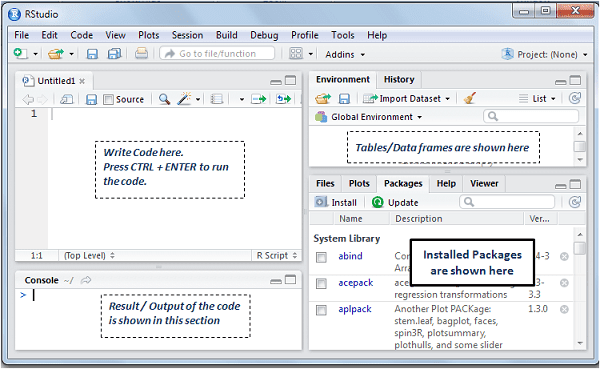R language is the world’s most widely used programming language for statistical analysis, predictive modeling and data science. It’s popularity is claimed in many recent surveys and studies. R programming language is getting powerful day by day as number of supported packages grows. Some of big IT companies such as Microsoft and IBM have also started developing packages on R and offering enterprise version of R.
Table of Contents
- 50 R Tutorials for Beginners
- 30+ Data Science with R Tutorials
- Text Mining with R
- R Interview Questions and Answers
What is R?
R is a free language and environment for statistical computing and graphics. You can perform a variety of tasks using R language. Some are as follows –
- Exploring and Manipulating Data
- Building and validating predictive models
- Applying machine learning and text mining algorithms
- Creating visually appealing graphs
- Connecting with Databases
- Building online dynamic reports or dashboards
- Send emails or push notification via R
Download best IDE for R i.e. RStudio by clicking on this link

What is RStudio and its benefits over standard R?
RStudio was built to make your life easy as a R programmer. It is available in open source for FREE. Unlike standard R, it supports various premium features such as intelligent code completion, syntax highlighting, structured R documentation, interactive debugging tool etc.
In layman’s term, RStudio is just an interface enhancement to standard R. Programming is similar in both the platforms.
- Companies using R
- Getting Started with R
- Data Types (Structures) in R
- Create Sample (Dummy) Data in R
- Importing Data into R
- Exporting Data in R
- Copy Data from Excel to R
- Loading and Saving Data with R
- Data Exploration with R
- Data Manipulation with R
- Data Manipulation with dplyr package
- Data Manipulation with data.table package
- If Else and Nested If Else in R
- Transpose Data with R
- Loops with R
- Error Handling in R
- Converting a factor to integer
- Character Functions
- Apply Function on Rows
- Keep / Drop Columns with R
- Joining and Merging with R
- Summarize Data with R
- Indexing Operators in List
- Split a data frame
- Convert data from wide to long format
- R Which Function Explained
- How to Update R Software
- Convert Backslash File Path to Forward Slash
- Send Email From R
- Run SQL Queries in R
- Measuring Execution Time of R Code
- Install an archived package
- Delete columns where certain % of missing values
- Converting multiple numeric variables to factor
- Extracting Numeric and Factor Variables
- Install R package from GitHub account
- Password Generator App with R
- Reading large CSV Files
- Creating Dummy Columns From Categorical Variables
- Convert Categorical Variables to Numeric
- CARET Package [Part I]
- CARET Package [Part II]
- Create Wordcloud with R
- Integrate R with PHP
Data Science with R Tutorials
These tutorials cover various data mining, machine learning and statistical techniques with R. It explains how to perform descriptive and inferential statistics, linear and logistic regression, time series, variable selection and dimensionality reduction, classification, market basket analysis, random forest, ensemble technique, clustering and more.
Topics covered:
- Case Studies : Data Science Training
- Linear Regression with R
- Logistic Regression with R
- Cluster Analysis with R
- Validate Cluster Analysis
- Decision Tree on Credit Data
- Random Forest Explained
- Gradient Boosting Model (GBM) with R
- Support Vector Machine (SVM) in R
- Market Basket Analysis
- ARIMA Modeling with R
- Dimensionality Reduction with R
- Correcting Collinearity with R
- Weighting in Decision Tree and SVM
- Decision Tree : Custom CTREE Plot
- Train Random Forest with CARET package
- Missing Value Imputation with Random Forest
- Speeding up Random Forest with R
- Variable Selection / Reduction with R
- Variable Selection – Wald Chi Square
- Predicting Transformed Dependent Variable
- Ensemble Learning : Stacking (Blending)
- Parallelizing Machine Learning Algorithms
- Ways to correct Class Imbalances / Rare Events
- Missing Imputation with Mice Package
- Predict Functions in R
- Splitting Data into Training and Validation Datasets
- R Function : Gain and Lift Table
- Automatically Create Model Formula
- Calculating AUC of Training Dataset
- R Functions : AUC and KS Statistics
- Two ways to train a model with R
